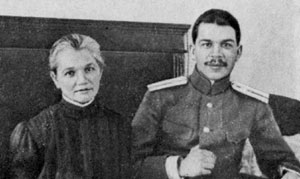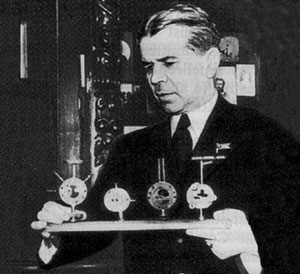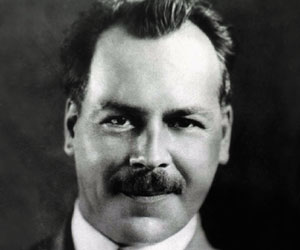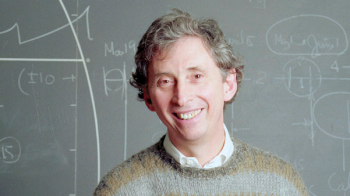Sergei Vavilov, whose research led to the discovery of Cherenkov radiation, contributed greatly to establishing a strong base for physics in the USSR, especially during the difficult years of the 1930s. In particular his efforts led to the founding of the Lebedev Physics Institute in Moscow 70 years ago.
Sergei Vavilov was born in Moscow in 1891. His father, a prosperous textile merchant, gave a good education to his two sons and hoped they would inherit and continue his business. However, Sergei and his elder brother Nikolai both decided to become scientists. Nikolai chose biology, while in 1909 Sergei entered the Department of Physics and Mathematics at Moscow University. As a second-year student he started work in the laboratory of Pyotr Nikolaevich Lebedev (1866-1912), who was famous for his experiments on the pressure of light on solids and gases. Vavilov became a great admirer of Lebedev’s style of work – an interest in the fundamental problems of physics blended with careful experiments.

After graduating with honours in 1914, Vavilov was called up for military service; a month later the First World War began. Vavilov served in various technical regiments, but by the end of 1917 the Russian front had collapsed because of the revolution and he was taken prisoner. He was interrogated by a German officer who happened to be a physicist and they spent all night discussing physics, especially Max Planck’s new theory of light. By morning the officer had helped Vavilov escape, and in February 1918 he appeared in Moscow. His father had by then lost all his property and emigrated from Russia, but Sergei and Nikolai did not want to leave their country; they realized that they had to coexist with the Soviet government as many other Russian scientists did. The government had decided that use should be made of scientific and technical specialists “in spite of the fact that they have been nourished upon capitalist ideology”. The 1920s were thus a period of great liberty for Russian scientists, despite civil war, widespread famine and economic collapse.
Bouger’s law and non-linear optics
In 1918 Vavilov started to work in the Physics and Biophysics Institute headed by Pyotr Petrovich Lazarev, a disciple of Lebedev who proposed that Vavilov pursue the topic of physical optics. He also lectured at Moscow University. From the start Vavilov was fascinated by the fundamental questions of the nature of light. He began with photoluminescence studies of solutions of organic dye molecules, and in 1919 conceived the idea for an experiment to confirm Max Planck’s quantum theory of light by measuring the coefficient of light absorption in optical media. According to Bouger’s law, this coefficient does not depend on its intensity; however, if Planck’s theory were correct it should be possible to see quantum fluctuations at very low or very high intensities of light, thus violating the law. Using dye solutions Vavilov and his students verified the law over a large range of incident light power, 10-11-108erg/cm2/s, and in 1920 they published a negative result; they did not see a violation of Bouger’s law.
During the following years Vavilov and his co-workers elucidated the principal laws of luminescence, introducing the term “luminescent yield” as the ratio of the luminescent energy to the energy of exiting light. They also investigated the mechanisms of luminescent quenching and Vavilov pioneered work on the development of new and economical light sources – luminescent lamps.
Continuing the work on the quantum nature of light, Vavilov decided to use an optical medium with a very-long-lived molecular excitation state to make it possible to see a violation of Bouger’s law. After a long search his team found a uranium glass with a glow lasting hundreds of thousands of times longer than that of dye solutions, and in 1926 Vavilov and Vadim Levshin finally discovered a violation of Bouger’s law at high intensities. They found a reduction in the absorption of light by uranium glass as the intensity of the light increased. Now known as the photorefractive effect, this was explained as resulting from the depopulation of the ground state by the incident beam. Vavilov introduced the term “non-linear optics”, which has since become a special subject of physics.
At the beginning of the 1930s the political climate in the USSR changed abruptly for the worse as Stalin consolidated his power. Numerous scientists were persecuted in Moscow, Leningrad and other cities. In March 1931 Lazarev was suddenly arrested and later exiled in the Urals. Colleagues lost their jobs at the institute, including Vavilov, although he kept his position as university professor. Academicians trying to preserve the Lebedev-Lazarev scientific school recommended Vavilov as a full member of the USSR Academy of Sciences, and he was elected in 1932.
Around the same time the director of the Optical Institute in Leningrad, Dmitri Rojdestvenski, invited Vavilov to join the staff in a bid to save the scientific programme from being stopped by the government to make way for the production of optical apparatus, especially for the military. Vavilov accepted and in 1932 was appointed head of research of the State Optical Institute. The same year he was asked by the Academy of Sciences to take charge of the academy’s small Physics Department in Leningrad. Vavilov invited several young physicists to join and organized investigations on the properties of neutrons, radiation-induced luminescence and coloured crystals.
The Vavliov-Cherenkov effect
In 1932 Vavilov and Eugeny Brumberg developed a photometric technique using the human eye as an instrument for measuring low light intensities close to the threshold of vision. This visual photometric method was very useful at a time when photomultipliers did not yet exist, and it was used in experiments performed in 1932-1941 that confirmed the statistical character of fluctuations in line with the ideas of quantum theory.
The same visual technique played a large role in the discovery of the Vavilov-Cherenkov effect. In 1933 Vavilov proposed to his postgraduate student, Pavel Cherenkov, the PhD topic: “The luminescence of the uranyl salt solutions under the influence of hard gamma radiation.” The task was to compare to what extent the luminescence properties of a salt solution in sulphuric acid exposed to gamma rays coincide with the previously studied luminescence of the same solution under light and X-ray irradiation.
The observed blue light was very weak, and to adapt his eyes Cherenkov had to stay in a totally dark room for an hour or more. In the course of measurements he found that a glow is emitted not only by the salt solution but by pure sulphuric acid as well. This situation proved to be a great nuisance to Cherenkov, who considered the glow to be a background obscuring the luminescence of the uranyl salt, so he asked to change the topic of his thesis. But Vavilov persuaded Cherenkov to continue the experiments and carefully purify the acid. When this did not help, Vavilov proposed checking if other pure solvents also emit light. Cherenkov investigated 16 different solvents of very high purity and found that the pure liquids all gleamed with nearly equal intensities under the action of gamma rays. Despite attempts to quench it by various means the mysterious radiation persisted.
Vavilov analysed all the measurements and arrived at the firm conclusion: “This is not a luminescence, this is a new optical phenomenon not known to science.” He also presented a first explanation – that the new radiation was produced by Compton electrons knocked out from the atoms of the liquid by gamma rays. In 1934 two articles were published in the same volume of the Reports of the Academy of Sciences, one signed by Cherenkov with his experimental results, the other by Vavilov in which he correctly postulated fast electrons as the origin of the new phenomenon.
In 1934 the Academy of Sciences moved from Leningrad to Moscow, and Vavilov’s Physics Department moved there too, to occupy what had been Lazarev’s building. Vavilov was determined to turn the small Physics Department into an institute covering the most important fields of physics. He obtained financial support from the government and began to organize the new Physics Institute of the Academy of Sciences. He was appointed as the first director and suggested that the new institute be named after Lebedev. He invited distinguished physicists to head the divisions he intended to create and some excellent young physicists to join the staff.

Though the 1930s were a very difficult time of political persecutions in the USSR, Vavilov managed to preserve a positive internal ambience in the Lebedev Institute, allowing the possibility for productive work. Vladimir Veksler wrote later: “I was lucky in that as a young scientist I was invited in 1936 to join the staff of the Lebedev Institute. An exciting atmosphere of complete commitment to science prevailed in the institute. My first impression of Vavilov was that his attitude was extremely affable and straightforward.”
In the laboratory of the Atomic Nucleus Division, Vavilov and Cherenkov continued to explore in detail the new radiation. They established that the radiation is emitted in a narrow cone close to the direction of the incident gamma-ray flux and is polarized along this direction. A magnetic field deflected the radiation, confirming Vavilov’s claim that it originated with charged particles. Vavilov constantly discussed the results of the experiments with theorists in the institute, trying to push them to work on the theory of effect. Finally, Ilya Frank and Igor Tamm became interested and in 1937 they gave a complete theoretical interpretation. “Vavilov enthralled me by his fascination with Cherenkov experiments,” Frank later wrote. In 1946 Vavilov, Cherenkov, Frank and Tamm were awarded the USSR State Prize in Science (the Stalin prize) for this discovery, and in 1958, seven years after Vavilov’s death, Cherenkov, Frank and Tamm received the accolade of the Nobel Prize in Physics. In his Nobel lecture Tamm said: “I should perhaps explain that we in the USSR use the name ‘Vavilov-Cherenkov radiation’ instead of just ‘Cherenkov radiation’ in order to emphasize the decisive role of the late Professor S Vavilov in the discovery of this radiation.”

By the 1930s Soviet nuclear physicists had reached a high level, mainly in the Leningrad Physics-Technical and Radium institutes and in Kharkov’s Polytechnical Institute. After visiting the USSR in 1936 Victor Weisskopf wrote: “Soviet physicists did not lag behind in their understanding of nuclear structure.” In 1938 Vavilov wrote a report about nuclear physics for the presidium of the Academy of Sciences, who decided to set up the Nuclear Physics Committee with Vavilov as chairman and Abram Ioffe, Igor Kurchatov, Pyotr Kapitza and Abram Alikhanov among its members.
Vavilov believed that experiments in nuclear physics required an accelerator bigger than the Radium Institute’s 10 MeV cyclotron, so in 1940 he organized a “cyclotron group” in the Lebedev Institute, consisting of young physicists whose goal was to find a way to construct a big cyclotron. When the members of this group told Vavilov about the huge difficulties, the answer was: “I don’t think there is no possibility of jumping over the relativistic barrier.” Then in 1944 Veksler wrote his famous two papers about the principle of phase stability, used in all modern particle accelerators. Vavilov immediately recommended them for publication and the decision was taken to start the construction of a 30 MeV synchrotron at the Lebedev Institute.
It was around this time that Vavilov was struck with the blow of the arrest, and later death, of his older brother Nikolai (1887-1943), an outstanding plant breeder and geneticist. The two brothers loved and influenced each other all their lives. Both were men of encyclopaedic knowledge, retentive memory, prodigious energy and personal charm, with a deep devotion to science. In the 1920s Nikolai had carved out a brilliant carrier in Russia. He was elected president of the Agricultural Academy and was at the head of research institutes of plant breeding in Leningrad and genetics in Moscow. He organized many expeditions throughout the world and created a huge seed collection. He also preserved and set up many experimental stations in different regions of the USSR and directed their programmes. However, Nikolai gained enemies driven by agronomist Trophim Lysenko and Marxist philosopher Isaak Present. Lysenko promised quick crop improvements, compared with Nikolai’s slow process of systematic hybridization and selection, and from 1935 Nikolai had to bear constant accusations of holding “idealist” Mendelian theories. Thousands of his colleagues and followers were removed from their teaching and research positions; many were arrested and some were shot. Nikolai’s agricultural programme was devastated and in 1940 he was arrested, tortured, tried and sentenced to be shot “for sabotaging Soviet agriculture and spying for England”. (He had worked on genetics in the UK in 1913-1914.) A year later the sentence was commuted to 20 years of forced labour, and in 1943 he died of starvation in Saratov prison. After Nikolai’s death, Sergei actively helped the family of his brother, and two of Nikolai’s sons became cosmic-ray physicists at the Lebedev Institute.
Not all of the sciences suffered as badly as biology, but Marxist philosophers assailed the “idealism” inherent in quantum mechanics and relativity theory. In 1937-1938 many physicists were arrested, and some were persecuted in the Lebedev Institute. Vavilov shielded the head of the Optics Division, Grigori Landsberg, the head of the Theory Division, Tamm (whose brother, the chief engineer of the chemical factory, was arrested), and others; he wrote directly to the chief prosecutor when Sergei Rytov, head of the Radiophysics Division, was arrested in 1937 (he was released in 1939).
Towards the hydrogen bomb
When Soviet physicists learned about the discovery of nuclear fission in 1939 they immediately proceeded to investigate the new phenomenon experimentally and theoretically. Most, including Ioffe and Kapitza, were sceptical about the possibility of utilizing atomic energy, but Tamm is reported to have said in August 1939, upon hearing a talk by Yakov Zeldovich and Yuly Khariton on their calculations of the number of neutrons emitted by fission: “Do you know what this discovery means? It means a bomb can be built that will destroy a city out to a radius of maybe ten kilometres.” (Halloway 1994.) Soviet authorities at the time thought that nuclear physics was a useless science, but Vavilov had a notion that in future it would be very significant. He had himself stayed as head of the Atomic Nucleus Physics Division of the Lebedev Institute until 1938, and gathered a team including Frank and Veksler. Later, in 1945, an engineer from the munitions plant, Andrei Sakharov, became Tamm’s postgraduate student.
On 22 June 1941 German armies unexpectedly crossed the Soviet border and rapidly progressed towards Leningrad and Moscow. This led the government to organize the evacuation of vital economic organizations towards the east of the country. By the end of July the Lebedev Institute was moved to Kazan and the Optics Institute was evacuated from Leningrad to a town 300 km from Kazan. Vavilov was appointed as adviser on optics to the USSR State Defence Committee and many research themes were changed to military tasks – every division in both institutes tried to produce equipment useful for the army.
In 1942 the Soviet government endorsed an atomic-bomb research programme and appointed Igor Kurchatov as its head. After the war Vavilov was ordered to participate in the state’s nuclear-weapons programme and he persuaded Tamm to create a special group including Vitaly Ginsburg and Sakharov. In 1948 Vavilov wrote to the government to inform them that significant results had been obtained in Tamm’s group on the development of the physical principles of a hydrogen bomb. The group was moved to the classified town of Arzamas-16, and on 12 August 1953 the world’s first compact hydrogen bomb, deliverable by plane or rocket, was successfully tested in the USSR, to the great surprise of Western physicists. Earlier, in 1950, Tamm and Sakharov created the theoretical basis for controlled thermonuclear fusion, so thermonuclear power could be used for peaceful means. Twenty-five years later, Sakharov, who had played a crucial role in the development of the Soviet hydrogen bomb, was awarded the Nobel Peace Prize for his championship of human rights, beginning in the 1960s. He was the sixth Lebedev physicist to be awarded the Nobel prize. (In 1964 Alexandre Prokhorov and Nikolai Basov received the Nobel Prize in Physics for the construction of oscillators based on the maser-laser principle.)

President of the Academy of Sciences
Vavilov was elected president of the USSR Academy of Sciences in July 1945. Many academicians thought there was not another scientist of so high a cultural level and such a provident, skillful administrator as Vavilov, and some recommended him for presidency. However, this could only have taken place if he were Stalin’s choice, so it was very hard for him to accept, as his brother Nikolai had been murdered by Stalin’s regime. The opinion of people close to Vavilov is that he accepted the post because he considered it his duty to serve science and the nation, rather than Stalin. During the time he was president he accomplished much to foster science in the USSR – the laboratories were better supplied with equipment and instruments, and the salaries of the researchers were increased.
Vavilov initiated the establishment of tens of new scientific and cultural institutions (research institutes, publishing houses, societies) but he understood and accepted the fact that he could do so only if the Communist Party saw them as useful politically or militarily. He briefed the authorities on the possibilities of new institutions and bargained to obtain the support he needed. In so doing he often had to act against his conscience and agree to distasteful compromises. Academician Leon Orbeli said in 1945: “Sergei Vavilov is a victim. He stayed on as head of the academy to save what could still be saved.” It was common knowledge that Vavilov was a kind and responsive person, and if he were able to help somebody by writing or signing a letter, acting as an intercedent or finding them a job, he would do so.
Vavilov was not only a distinguished researcher. From 1932 until the end of his life he had to spend part, and later most of his time, performing administrative functions in science and supervising young scientists. He made a great contribution to the growth of the State Optics Institute, which now bears his name, and the Lebedev Physics Institute.
All his life he was greatly interested in the history and popularization of science. He wrote popular books on optics and scientific biographies of Galileo, Grimaldi, Huygens, Faraday, Michelson, Newton, Euler, Lomonosov, Lebedev, Lazarev and others. He also translated Newton’s Optics and Lectures on Optics and Lucretius’ De rerum Natura from Latin to Russian, and published them with his own comments.
What Vavilov did during his five-year presidency is so beautiful and extensive that future generations will remember him with deep respect and gratitude.
Ilya Frank
In the end, being president of the academy under the brutal dictatorial regime of Stalin was a source of appalling stress. Vavilov’s health was seriously damaged and he died of a heart attack in 1951, two months before his 60th birthday (and two years before Stalin’s death).
Frank preserved his respect and affection for his beloved teacher until the end of his days. He compiled and edited a collection of reminiscences about Vavilov, which was published in three volumes. Frank was very ill when he was working on the third volume in 1991 and afraid he would die without finishing the work. When he completed the manuscript he emerged from his study at home and joyfully informed his family that the book had been finished, adding: “Now at last I can die.” He died a few days later.
Frank wrote: “What [Vavilov] did during his five-year presidency is so beautiful and extensive that future generations will remember him with deep respect and gratitude.”
Further reading
M V Alfimov et al. 2001 The 110th anniversary of the birth of S I Vavilov
Physics-Uspekhi 44 1017-1036.
Loren R Graham 1993 Science in Russia and the Soviet Union (Cambridge University Press).
David Halloway 1994 Stalin and the Bomb(Yale University Press).
S I Vavilov 1947 Newton and the Atomic Theory The Royal Society Newton Tercentenary Celebrations (Cambridge, Royal Society).
Y N Vavilov 2004 Long Search: A Book About Brothers Nikolai and Sergei Vavilov (FIAN Moscow).








